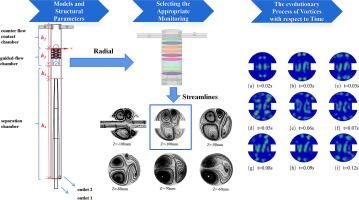Numerical of vortex characteristics in a counter flow contact-cyclone reactor for epoxidation of fatty acid methyl ester
IF 3.9
3区 工程技术
Q3 ENERGY & FUELS
Chemical Engineering and Processing - Process Intensification
Pub Date : 2025-07-28
DOI:10.1016/j.cep.2025.110475
引用次数: 0
Abstract
Using Eulerian model and RSM model, the vortex characteristics of the flow field with a counter flow contact-cyclone reactor for epoxidation of fatty acid methyl esters were analyzed. The impinging stream technology was used to optimize the mixing and reaction of FAME and performic acid. By varying the impingement distance (L1) and accelerator tube length (L2), the vorticity, swirling strength, and vortex kinetic energy distribution of the flow field were discussed using vorticity, normalized swirling strength standard deviation, and Q-criterion. Furthermore, the vortex core interaction range and evolution process in the reactor were studied based on the radial variations of vorticity and swirling strength standard deviation. Significantly, when L1 = 40 mm and L2 = 30 mm, the development of the vorticity reached the optimal working condition. Analysis of vorticity and Q-criterion isosurfaces indicates that small-scale vortices are distributed near the impingement chamber walls, while large-scale vortices are located at the impingement center. Notably, the vortex structures in the counter flow contact chamber are dominated by horseshoe and ribbed vortices. The evolution of vortices in the radial plane of the counter flow contact chamber is divided into four stages according to Q-criterion variations, and the flow field stabilizes after t = 0.18 s.

脂肪酸甲酯环氧化逆流接触旋流反应器涡特性数值模拟
采用欧拉模型和RSM模型,对逆流式接触旋流反应器中脂肪酸甲酯环氧化反应的流场涡特性进行了分析。采用冲击流技术对FAME与甲酸的混合反应进行了优化。通过改变撞击距离(L1)和加速管长度(L2),利用涡量、归一化旋流强度标准差和q准则讨论了流场的涡度、旋流强度和涡动能分布。基于涡度和旋流强度标准差的径向变化,研究了反应器内涡芯相互作用范围和演化过程。值得注意的是,当L1 = 40 mm, L2 = 30 mm时,涡量的发展达到了最佳工作状态。涡度和q准则等值面分析表明,小尺度涡分布在撞击室壁面附近,大尺度涡分布在撞击中心。值得注意的是,逆流接触室内的涡结构以马蹄形涡和肋形涡为主。根据q准则的变化,将逆流接触室径向面涡的演化分为4个阶段,流场在t = 0.18 s后趋于稳定。
本文章由计算机程序翻译,如有差异,请以英文原文为准。
求助全文
约1分钟内获得全文
求助全文
来源期刊
CiteScore
7.80
自引率
9.30%
发文量
408
审稿时长
49 days
期刊介绍:
Chemical Engineering and Processing: Process Intensification is intended for practicing researchers in industry and academia, working in the field of Process Engineering and related to the subject of Process Intensification.Articles published in the Journal demonstrate how novel discoveries, developments and theories in the field of Process Engineering and in particular Process Intensification may be used for analysis and design of innovative equipment and processing methods with substantially improved sustainability, efficiency and environmental performance.

 求助内容:
求助内容: 应助结果提醒方式:
应助结果提醒方式:


